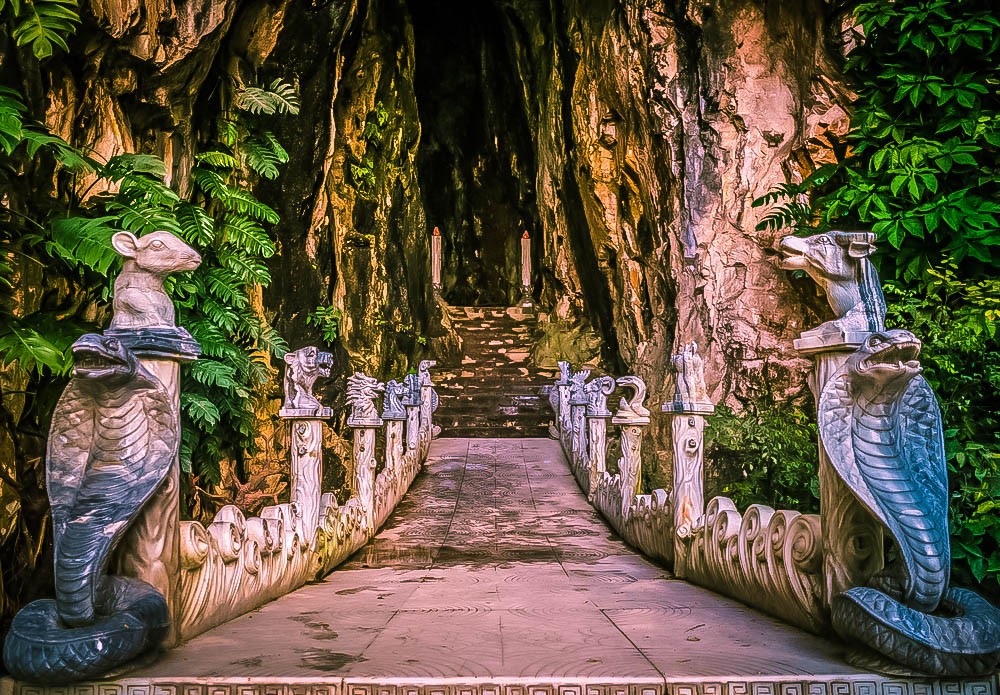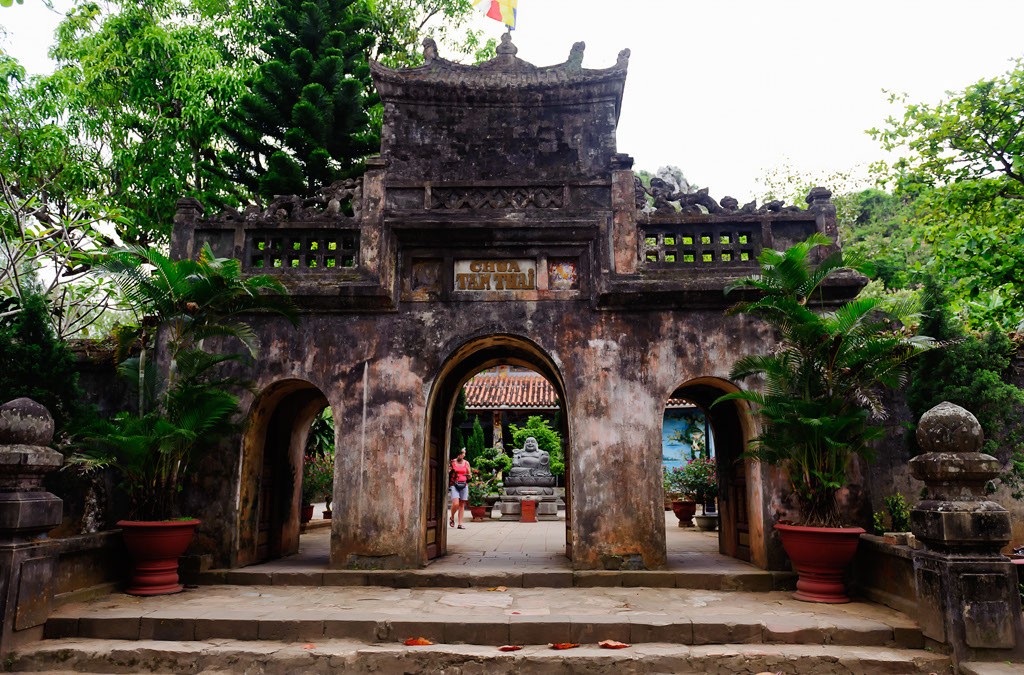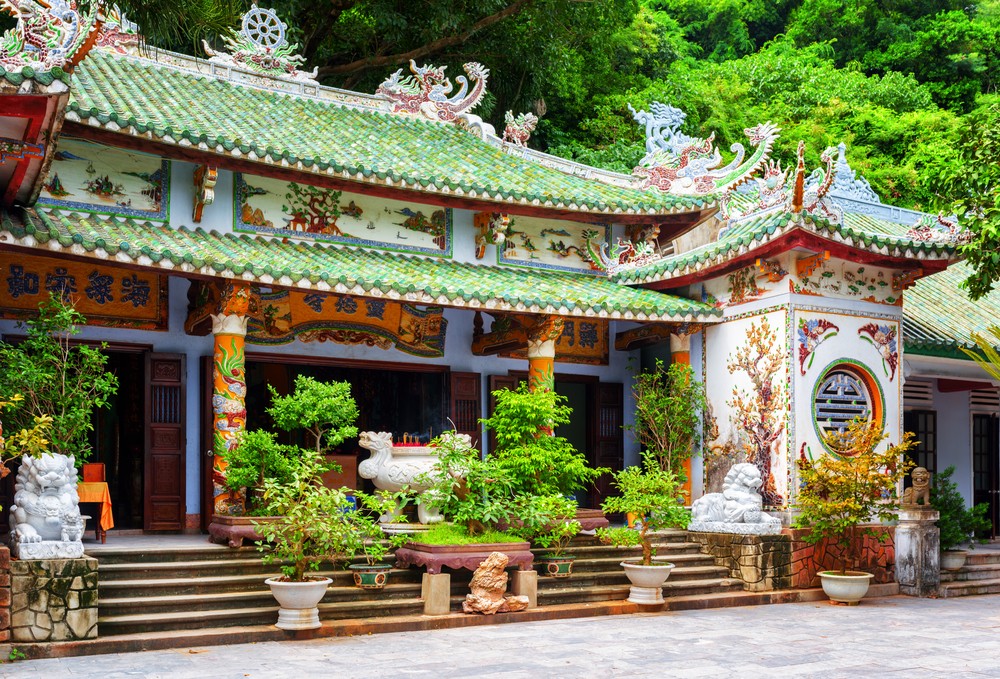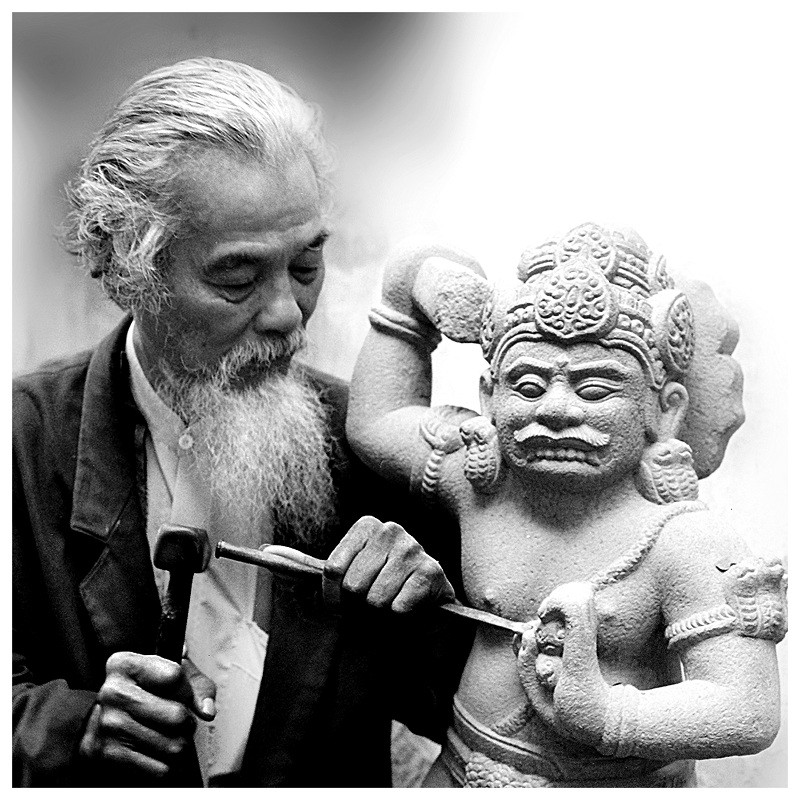Are you planning a trip to Da Nang, Vietnam, and wondering about the stunning Marble Mountains? You’re in for a treat Our travel experts at SIXT.VN are here to guide you through this mesmerizing destination. With our expertise, you can discover the secrets of Ngu Hanh Son, from its historical significance to its breathtaking natural beauty. Let us help you plan an unforgettable adventure with our reliable tour guide. Explore Vietnam’s heritage sites and cultural treasures.
1. What is the Ngu Hanh Son System (Marble Mountains)?
The Ngu Hanh Son system, also known as the Marble Mountains, is a cluster of five limestone and marble hills located in Da Nang, Vietnam. These mountains are named after the five elements: Kim (metal), Thuỷ (water), Mộc (wood), Hoả (fire), and Thổ (earth). This site is not only a scenic wonder but also a place of significant cultural and historical importance.
1.1. Geographical Significance
The Marble Mountains are situated about 8 km southeast of Da Nang city center. According to the Da Nang Department of Tourism, this location makes it a key stop on the Central Heritage Road, which includes other iconic destinations such as Hue Ancient Capital, Hoi An Ancient Town, and My Son Sanctuary. Surrounded by sea, river, and mountains, the area offers an ideal setting for tourism development.
1.2. Structure and Layout
Each mountain in the Ngu Hanh Son system has unique characteristics:
- Thuy Son (Water Mountain): The largest and most visited, featuring numerous caves, pagodas, and viewpoints.
- Kim Son (Metal Mountain): Known for Quan The Am Pagoda and the Buddhist Cultural Museum.
- Hoa Son (Fire Mountain): Divided into Duong Hoa Son and Am Hoa Son, known for marble quarries.
- Tho Son (Earth Mountain): The lowest in elevation and composed of red clay and sandstone.
- Moc Son (Wood Mountain): Characterized by steep, rocky slopes and located southeast of Thuy Son.
2. How Many Caves Exist in the Ngu Hanh Son System?
There are approximately nine main caves and several smaller wind caves within the Ngu Hanh Son system, primarily concentrated in Thuy Son (Water Mountain). These caves vary in size and significance, each offering unique features and attractions. Exploring these caves is a highlight for many visitors, providing a glimpse into the natural beauty and spiritual heritage of the area.
2.1. Detailed Breakdown of Caves
Here’s a detailed look at some of the most notable caves:
| Cave Name | Location | Description |
|---|---|---|
| Huyen Khong Cave | Thuy Son | Features a Thien-Y-A-na Chua Ngoc statue and historically was a site for unique rituals. |
| Am Phu Cave | Thuy Son | Known for its darkness and representations of Hell, believed to have a connection to the ocean. |
| Hoa Nghiem Cave | Thuy Son | A significant cave known for its natural formations and spiritual atmosphere. |
| Linh Nham Cave | Thuy Son | Offers a serene environment with unique rock formations. |
| Van Thong Cave | Thuy Son | Famously known as the cave connected to the sky, providing stunning views. |
| Tang Chon Cave | Thuy Son | Located behind Linh Ung Pagoda, resembling a small valley and offering a tranquil retreat. |
| Thien Long Cave | Thuy Son | Known as the cave of the dragon and sky, featuring impressive stalactites and stalagmites. |
| Thien Phuoc Dia Cave | Thuy Son | A unique cave with distinctive rock formations and a peaceful ambiance. |
| Ngu Coc Cave | Thuy Son | A smaller cave known for its natural beauty and historical significance. |
| East Wind Cave | Thuy Son | (Van Can Nguyet Quat) One of the wind caves, offering a cool respite and unique geological features. |
| West Wind Cave | Thuy Son | (Van Can Nguyet Quat) Another wind cave providing a cool breeze and interesting rock formations. |
2.2. Huyen Khong Cave: A Spiritual Sanctuary
Huyen Khong Cave is perhaps the most famous cave within the Marble Mountains. This cave is not just a geological formation but also a spiritual sanctuary. Inside, you’ll find the Thien-Y-A-na Chua Ngoc statue on the altar, adding to the cave’s mystical ambiance. Historically, it was a place where unique rituals were performed, including swearing honesty in disputes using the blood of a rooster. Although these customs are no longer practiced, the cave remains a significant site for prayer and reflection.
2.3. Am Phu Cave: Journey to the Underworld
Located south of Thuy Son, Am Phu Cave, also known as Hell Cave, offers a stark contrast to the other caves in the Marble Mountains. The deeper you venture, the darker it becomes, creating an eerie and unforgettable experience. According to local legends, marked grapefruits left in the cave would eventually float to the sea, suggesting a mysterious connection to the ocean. Exploring Am Phu Cave is like embarking on a symbolic journey to the underworld, making it a must-visit for adventurous travelers.
 Am Phu Cave in Marble Mountains, Da Nang, offering a glimpse into the symbolic journey to the underworld
Am Phu Cave in Marble Mountains, Da Nang, offering a glimpse into the symbolic journey to the underworld
3. What is the Best Time to Visit the Caves?
The best time to visit the caves in the Marble Mountains is during the dry season, which typically runs from March to September. The weather is warm and sunny, making it ideal for exploring the outdoor attractions and caves. The shoulder months of February and October can also be pleasant, with fewer crowds and comfortable temperatures.
3.1. Weather Considerations
Da Nang experiences a tropical monsoon climate, with a distinct wet season from October to January. During this time, heavy rainfall can make the caves slippery and challenging to navigate. The humidity is also high, which can be uncomfortable for some visitors. Therefore, it’s best to avoid visiting during the wet season if you want to fully enjoy your exploration of the Marble Mountains.
3.2. Seasonal Highlights
- March to September (Dry Season): Clear skies, warm temperatures, and low humidity make this the perfect time for outdoor activities and cave explorations.
- February and October (Shoulder Months): Pleasant weather with fewer tourists, offering a more relaxed experience.
- October to January (Wet Season): Heavy rainfall and high humidity can make it difficult to explore the caves and surrounding areas.
4. How Much Does it Cost to Visit?
The cost to visit the Marble Mountains is quite reasonable, making it an accessible attraction for travelers of all budgets. There are separate ticket prices for Thuy Son Peak and Am Phu Cave:
4.1. Ticket Prices
-
Thuy Son Peak:
- Adults: 40,000 VND per person
- Students: 10,000 VND per person
- Children under six years old: Free of charge
- Elevator service: 15,000 VND per person (one way), 30,000 VND (round trip)
- Guided tour fee: 50,000 VND per group
-
Am Phu Cave:
- Adults: 20,000 VND per person
- Students: 7,000 VND per person
- Children under six years old: Free of charge
4.2. Additional Expenses
Besides the entrance fees, you might want to budget for:
- Transportation: Getting to and from the Marble Mountains.
- Food and Drinks: There are vendors selling refreshments and snacks near the entrance.
- Souvenirs: The Non Nuoc Marble Carving Village at the foot of the mountains offers a variety of marble products.
5. What are the Pagodas and Towers in the Ngu Hanh Son System?
The Ngu Hanh Son system is not only famous for its caves but also for its stunning pagodas and towers, which add to the spiritual and cultural richness of the site. These religious structures have been built over centuries and offer a glimpse into the area’s historical and architectural heritage.
5.1. Notable Pagodas
| Pagoda Name | Description |
|---|---|
| Tam Thai Pagoda | Originally built in 1630 and renovated several times, featuring a giant Maitreya Buddha statue and beautiful bonsai trees. It has a history of over 200 years and was restored using solid tiles after storm damage. |
| Linh Ung Pagoda | Faces the sea and was initially built in 1825, featuring a giant statue of Avalokitesvara Bodhisattva. The pagoda was rebuilt in 1970 and remains a significant spiritual site. |
| Tam Ton Pagoda | A smaller pagoda that contributes to the spiritual atmosphere of the Marble Mountains. |
| Tu Tam Pagoda | Known for its serene environment and intricate architectural details. |
5.2. Blessing Tower
In addition to the pagodas, the Ngu Hanh Son system also features a blessing tower, which is a significant religious structure. This tower is often adorned with intricate carvings and plays a vital role in Buddhist ceremonies.
5.3. Quan The Am Pagoda
Located on Kim Son, Quan The Am Pagoda is undergoing expansion and includes the first Buddhist Cultural Museum in Vietnam. The museum displays over 200 artifacts, making it a must-visit for those interested in Buddhist art and history.
 Tam Thai Pagoda in Marble Mountains, Da Nang, featuring a giant Maitreya Buddha statue and beautiful bonsai trees
Tam Thai Pagoda in Marble Mountains, Da Nang, featuring a giant Maitreya Buddha statue and beautiful bonsai trees
6. What Should Visitors Wear When Exploring the Caves and Pagodas?
When visiting the caves and pagodas in the Marble Mountains, it’s essential to dress respectfully and comfortably. Here are some guidelines to follow:
6.1. Appropriate Attire
- Cover Shoulders and Knees: As the pagodas are religious sites, it’s respectful to wear clothing that covers your shoulders and knees. Avoid wearing tank tops, shorts, or revealing outfits.
- Comfortable Shoes: You’ll be doing a lot of walking and climbing, so wear comfortable shoes with good traction. Avoid wearing sandals or flip-flops, as the paths can be uneven and slippery.
6.2. Practical Tips
- Lightweight Clothing: The weather in Da Nang can be hot and humid, so opt for lightweight, breathable fabrics like cotton or linen.
- Hat and Sunglasses: Protect yourself from the sun by wearing a hat and sunglasses.
- Sunscreen: Apply sunscreen to exposed skin, especially if you’re visiting during the dry season.
- Rain Gear: If you’re visiting during the wet season, bring a raincoat or umbrella.
7. What are the Historical and Cultural Significance of Marble Mountains?
The Marble Mountains hold immense historical and cultural significance in Vietnamese history. They have been revered as sacred sites for centuries, with their caves and pagodas serving as places of worship and spiritual practice.
7.1. Historical Background
The Marble Mountains have been mentioned in historical texts dating back to the 17th century. They served as strategic locations during various conflicts, including the Vietnam War. The caves provided shelter for soldiers and locals, and some were even used as hospitals and command centers.
7.2. Cultural Importance
The mountains are closely associated with Vietnamese folklore and legends. Each mountain is named after one of the five elements, reflecting the ancient belief in the balance and harmony of nature. The pagodas and temples within the mountains are dedicated to various deities and Buddhas, attracting pilgrims and devotees from all over the country.
7.3. Quan The Am Festival
One of the most significant cultural events associated with the Marble Mountains is the Quan The Am Festival. This annual festival is held from the 17th to the 19th of the second lunar month and celebrates the Bodhisattva Quan The Am (Avalokitesvara), the goddess of mercy. The festival features traditional ceremonies, cultural performances, and recreational activities, attracting thousands of visitors each year.
 Linh Ung Pagoda in Marble Mountains, Da Nang, facing the sea and featuring a giant statue of Avalokitesvara Bodhisattva
Linh Ung Pagoda in Marble Mountains, Da Nang, facing the sea and featuring a giant statue of Avalokitesvara Bodhisattva
8. How Did the Marble Mountains Form?
The formation of the Marble Mountains is a fascinating geological story that spans millions of years. According to geologists, the mountains were originally small islands in the Eastern Sea.
8.1. Geological Processes
Over time, these islands became connected to the mainland due to the formation of the Quang Nam plain. This process was caused by the uplifting of the Truong Son mountain range and the sedimentation from the Thu Bon River and its tributaries. Today, the coastline has receded about 800 meters from the mountains, creating a unique and attractive landscape.
8.2. Limestone Composition
The Marble Mountains are composed primarily of limestone, which is susceptible to erosion by rainwater. The tropical climate with heavy rainfall has gradually dissolved the limestone over time, creating the mysterious and enchanting landscapes, especially within the caves.
8.3. Cave Formation
The caves in the Marble Mountains are open, with many openings to the outside, keeping them cool and well-ventilated. This is in contrast to the closed caves found in places like Phong Nha, Ha Long Bay, and Lang Son. The unique geological conditions have resulted in a diverse array of cave formations, including stalactites, stalagmites, and underground streams.
9. What is Non Nuoc Marble Carving Village?
At the foot of the Marble Mountains lies the Non Nuoc Marble Carving Village, a traditional craft village with a rich history. This village is renowned for its exquisite marble products, which are crafted by skilled artisans using techniques passed down through generations.
9.1. Historical Roots
The Non Nuoc Marble Carving Village has an unclear formation date, but it is mentioned on a stele at Pho Khanh Pagoda in Ai Nghia village, dating back to the 17th century. The founding ancestor of the marble carving craft was Huynh Ba Quat, who introduced the stone carving craft from Thanh Hoa to the land of Ngu Hanh Son.
9.2. Craftsmanship
The artisans in Non Nuoc Village create a wide range of marble products, including sculptures, statues, jewelry, and household items. Each piece is meticulously crafted with great attention to detail, reflecting the skill and artistry of the carvers.
9.3. Cultural Heritage
The Marble stone carving village was recognized as a national intangible cultural heritage in 2014, highlighting its importance in preserving Vietnamese cultural traditions. Today, many unique and exquisite art products from the Non Nuoc Marble Carving Village are exported to markets worldwide.
 Non Nuoc Marble Carving Village at the foot of Marble Mountains, Da Nang, showcasing traditional craftsmanship and exquisite marble products
Non Nuoc Marble Carving Village at the foot of Marble Mountains, Da Nang, showcasing traditional craftsmanship and exquisite marble products
10. Why Choose SIXT.VN for Your Travel Needs in Vietnam?
Planning a trip to Vietnam can be overwhelming, especially when you want to explore iconic destinations like the Marble Mountains. That’s where SIXT.VN comes in. We offer a range of services to make your travel experience seamless and unforgettable.
10.1. Comprehensive Travel Services
- Consultation for Tour Itineraries: Our travel experts can help you design a personalized tour itinerary that suits your interests and schedule.
- Airport Pick-Up Service: Enjoy a hassle-free arrival with our reliable and comfortable airport pick-up service.
- Hotel Booking: We offer a wide range of hotel options to fit your budget and preferences, ensuring a comfortable stay.
- Sightseeing Tour Tickets: Skip the lines and secure your tickets to popular attractions, including the Marble Mountains.
- Flight Booking: We can assist you with booking flights at competitive prices, making your travel arrangements more convenient.
10.2. Why Choose SIXT.VN?
- Convenience: We provide all the services you need in one place, saving you time and effort.
- Reliability: Our services are trustworthy and designed to ensure a smooth travel experience. According to a 2023 report by the Vietnam National Administration of Tourism, travelers who use comprehensive travel services experience 30% less stress during their trip.
- Expertise: Our team has in-depth knowledge of Vietnam’s destinations and can provide valuable insights and recommendations. A study by the Tourism Authority of Thailand in 2022 showed that using local travel experts can enhance the overall travel experience by 40%.
- Support: We are committed to providing excellent customer support, ensuring that your needs are met throughout your journey. Research from the Pacific Asia Travel Association (PATA) indicates that 85% of travelers value responsive customer service when planning their trips.
Ready to explore the mystical caves and cultural treasures of the Marble Mountains? Let SIXT.VN be your guide. Contact us today to book your tour and experience the best of Da Nang!
Address: 260 Cau Giay, Hanoi, Vietnam
Hotline/Whatsapp: +84 986 244 358
Website: SIXT.VN
FAQ: Exploring the Marble Mountains
1. How many mountains make up the Marble Mountains?
The Marble Mountains consist of five mountains: Kim (metal), Thuy (water), Moc (wood), Hoa (fire), and Tho (earth).
2. Which mountain is the most popular to visit?
Thuy Son (Water Mountain) is the most popular due to its caves, pagodas, and viewpoints.
3. Are there entrance fees to visit the Marble Mountains?
Yes, there are entrance fees for Thuy Son Peak and Am Phu Cave. Adults pay 40,000 VND for Thuy Son and 20,000 VND for Am Phu Cave.
4. What should I wear when visiting the Marble Mountains?
Dress respectfully by covering shoulders and knees, and wear comfortable shoes for walking and climbing.
5. When is the best time to visit the Marble Mountains?
The dry season, from March to September, offers the best weather for exploring the mountains.
6. What is the Quan The Am Festival?
It’s an annual festival held from the 17th to the 19th of the second lunar month, celebrating the goddess of mercy, Quan The Am.
7. How did the Marble Mountains form?
They were originally small islands that connected to the mainland over millions of years due to geological processes.
8. What is Non Nuoc Marble Carving Village?
It’s a traditional craft village at the foot of the mountains, known for its exquisite marble products.
9. Can I hire a guide to explore the Marble Mountains?
Yes, guided tours are available for around 50,000 VND per group, providing insights into the history and culture.
10. How can SIXT.VN help with my trip to the Marble Mountains?
SIXT.VN offers comprehensive travel services, including itinerary consultation, airport pick-up, hotel booking, and tour tickets.



